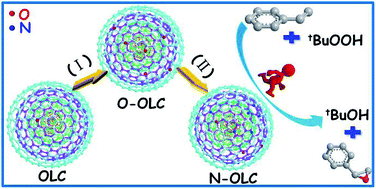Nitrogen-doped onion-like carbon: a novel and efficient metal-free catalyst for epoxidation reaction†
Abstract
Onion-like carbon (OLC) as a promising carbon material has attracted extensive interest in many fields. In this work, we report for the first time the controllable synthesis of nitrogen-doped OLC via nitric acid pretreatment, followed by different temperature calcination treatment under an ammonia atmosphere. The detailed physicochemical properties of the doped OLC samples are investigated by high resolution transmission electron microscopy (HRTEM), Raman spectroscopy, X-ray photoelectron spectroscopy (XPS), elemental analysis (EA) and electron energy loss spectroscopy (EELS). Moreover, the potential catalytic performance of such doped samples is evidenced by styrene epoxidation reaction, a kind of typical metal-related catalytic reaction. The results indicate that doped OLC samples exhibit more excellent catalytic performance than pristine OLC and some reported metal-related catalysts. The graphitic nitrogen species plays a key role in the catalytic reaction based on some control experiments and a good linear correlation between the content of this species and the activity results. Our work provides valuable information on the design and application of modified carbon materials in catalytic reactions.


 Please wait while we load your content...
Please wait while we load your content...